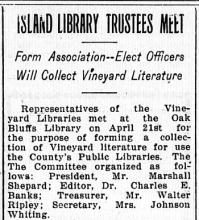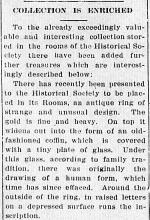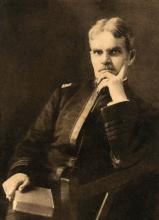Hens’ gravestones, a scrimshaw toothpick, a spittoon of General Grant’s, a plank from the Constitution and a spanker for naughty boys are among the many curiosities on display at the Duke’s County Historical Society museum on School street in Edgartown.
The museum merits attention, not because it is new - the Squrie Cooke house that contains these memorabilia of Island history has occupied the same site since 1765 - but because there are many Vineyard visitors who are either unaware of its existence, or bypass it expecting must and dust. Far from being musty, the Historical Society is well kept and rich in contents and lore. Visitors are greeted by pert and pretty hostess-guides who tell fascinating tales of sea captains, shipwrecks and whale oil candle factories.
The squire for whom the house was built was one of the Island’s leading citizens in the late 18th century. He was the second collector of customs on the Vineyard and a justice of the court of common pleas. It was a common saying in his day that a man would have justice “if there’s any law in Cooke’s house.”
Cambered House
Its interior has scarcely been altered, structurally, since 1765, and it is something of an architectural curiosity, for it is a cambered house, built by ship’s carpenters in the same way that would have built a vessel. As a ship’s decks were built in those days to fall away toward the rail so the water would run off, so Squire Cooke’s house was constructed so that floors, ceiling, lintels - everything - falls away from the central chimney. In the case of the house, this construction was not to keep the floors dry, but apparently the builders thought that the cambered - curved - timbers used in ships were best able to withstand stress and strain. Visitors to the house today, however, are frequently agog, and even made a little seasick by the slant of the floors, and the uneven proportions of door jambs and cornices.
Wallpaper, of course, deteriorates through the years, and this has been replaced, but always with a view to keeping it in a period design. One pretty design is of rose-colored passion flowers. This paper, it is said, follows a pattern used by a Salem merchant who had a daughter fast approaching spinster hood. To make her a more tempting marriage partner, he built a house for her and, enticingly, papered the hall with the passion flower design. The enticement worked. Within a matter of months she was married, though to neither merchant nor whaling captain; she ran away with a sailor.
Much of the memorabilia in the museum is of the sea. The designer and builder of the Constitution was a Chilmark man, Col. George Claghorn, and a damaged timber from the bow of the vessel, as she was originally built, is on display. A member of the maintenance crew of the reconstructed Constitution, which is now berthed in Boston, said that the Historical Society’s timber was probably the only existing original timber of the boat, for she has been so often repaired.
Melville’s Signature
On his one whaling voyage, on which he garnered the material for Omoo, Typee and Moby Dick, Herman Melville shipped out on a vessel whose master was Capt. Valentine Pease of Edgartown, and the crew list, including the author’s signature, hangs on a wall in an upper room of the Squire Cooke house. The room in which it hangs was the original customs collecting office.
Pie crimpers, etched whale’s teeth, mother and daughter-sized rolling pins, knitting needles, dice boxes, cribbage boards, napkin rings and clothespins of scrimshaw are also here, along with baleen, the bone “fringe” for shelving food, from the upper jaw of a right whale.
Because so many whalemen were away from home for so long, and in such exotic ports, there is an abundance of gifts brought home from Alaska, the South Pacific, Hawaii, the Orient. Some of these were partially handcrafted by the seamen on their seemingly enless voyages - among these is a “love tocken” of inlaid Polynesian wood with whale’s teeth set in its top and feet that are tiny high-button shoes of scrimshaw, fashioned as the captain remembered his wife’s boots to be fashioned.
There is also a set of miniature red teacups from China used for sampling tea before bringing it home, a Chinese bridal chest gracefully decorated with a white floral design and several mother of pearl trinket boxes. A jewelry box of shells was an engagement present to Eliza Crocker Osborn of Edgartown.
The sea-minded will also find a bailer shell used by Pacific peoples to bail water from their canoes, leg irons used on recalcitrant seamen, logbooks, a South Pacific dugout, the stern carving from a whaleboat, a whaleboat keg used to carry fresh water or biscuits, harpoons galore and the stamps used on logbooks to indicate the different kinds of whales sighted, caught or lost on a voyage.
The whaleboat that never lost a race in 30 years is on display. Frequently, when whaling ships came in, their boats were raced by the ship’s crew as a between-voyages pastime, and the one handled by Capt. Isaac Norton of Edgartown and his crew was famous for its winning streaks.
Bounty of Models
For visitors with a fondness for ship’s models, there are all sorts and kinds - a side-wheeler that ran between New York and Boston (and that, one spring when the museum was opened, was found to have a colony of bees booked into its staterooms); a Spanish-American War battleship; a schooner in which lumber was brought from Maine to help in the building of the Cottage City Camp Ground in 1875.
The museum has two rooms devoted to the Camp Ground, filled with such Victorian treasures as a wreath of shell flowers fashioned by a whaling wife while she waited for her husband to come home from the sea; waxed paper flowers of the 1870s and horsehair-stuffed furniture. In the Lucy and Sarah Adams room, the two Vineyard sisters who were bridesmaids at Mrs. Tom Thumb’s marriage to her second husband (after Tom Thumb’s death), are remembered with the tiny footstool that they took to church because their legs were too short to reach the floor (Miss Sarah was 46 inches tall; Miss Lucy 49 inches). There, too, are their child-sized chairs and a carefully framed collection of pictures of the two ladies’ rejected suitors. Affixed beneath is the comment, written by the sisters, “The Little Adams Sisters were never married, but here are photos of some of their rejected suitors.” There are six in the category.
In the museum’s costume room are whaleskin stays, a bearskin coat made by Eskimos for a Vineyard bride who joined her husband on an Arctic voyage, a maternity dress of 1898, a child’s calico dress of the 1700s.
Objects unlikely to be seen elsewhere are stuffed heath hens - the prairie-chicken-like birds, no extinct, that once inhabited the Island and the gravestones Nancy Luce had erected when her hens died. A mid 19th century resident of West Tisbury, Nancy Luce lived alone and made pets of her hens. Among their gravestones are the ones under which once lay buried Poor Tweedle Dedel and Bebbee Pinky, Ada Queetie and Bueaty Linna.
Driftwood Highboy
There is also a mahogany highboy made from driftwood that was found on an Island beach in the 18th century by three girls who went swimming one moonlight night. (Since girls were not supposed to do any more than wade, and these three thoroughly enjoyed a genuine plunge, they frequently went bathing in the early evening when they were less likely to be seen and their activity frowned upon.) The pile of driftwood was divided among the three, and a Vineyard cabinet maker built a highboy and dining room table for each of the girls. The one that was made for Hannah Harper is now in the Squire Cooke House.
On an Island steamer, the Monahansett, taken for government service during the Civil War, President Lincoln met once with General Grant to discuss the progress of the war. Eventually, the ship returned to the Island run and the table the two dignitaries had used during their discussions was given to the boat’s captain - Hiram Crowell of Edgartown. It is now Historical Society property, as is a spittoon that was used by General Grant, who once visited the Island as a Camp Ground guest of Captain Crowell.
There is something for everyone at Squire Cooke’s.











Comments